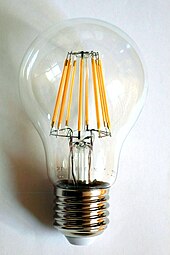
Back مصباح ثنائي باعث للضوء Arabic LED lampa AZ Святлодыёдная лямпа BE Сьвятлодыёдная лямпа BE-X-OLD LED лампи Bulgarian এলইডি বাতি Bengali/Bangla Llum LED Catalan LED žárovka Czech Lysdiodelampe Danish LED-Leuchtmittel German
 | |
| Type | Light-emitting diode, light bulb |
|---|---|
| First production | 1968 |



An LED lamp or LED light[1] is an electric light that produces light using light-emitting diodes (LEDs). LED lamps are significantly more energy-efficient than equivalent incandescent lamps and fluorescent lamps.[2][3][4] The most efficient commercially available LED lamps have efficiencies exceeding 200 lumens per watt (lm/W) and convert more than half the input power into light.[5][6][7] Commercial LED lamps have a lifespan several times longer than both incandescent and fluorescent lamps.
LED lamps require an electronic LED circuit to operate from mains power lines, and losses from this circuit means that the efficiency of the lamp is lower than the efficiency of the LED chips it uses. The driver circuit may require special features to be compatible with lamp dimmers intended for use on incandescent lamps. Generally the current waveform contains some amount of distortion, depending on the luminaires' technology.[8]
The LED lamp market is projected to grow from US$75.8 billion in 2020 to US$160 billion in 2026.[9]
LEDs come to full brightness immediately with no warm-up delay. Frequent switching on and off does not reduce life expectancy as with fluorescent lighting.[10] Light output decreases gradually over the lifetime of the LED.
Some LED lamps are drop-in replacements for incandescent or fluorescent lamps. LED lamps may use multiple LED packages for improved light dispersal, heat dissipation, and overall cost. The text on retail LED lamp packaging may show the light output in lumens, the power consumption in watts, the color temperature in kelvins or a color description such as "warm white", "cool white" or "daylight", the operating temperature range, whether the lamp is dimmer compatible, whether the lamp is suitable for humid/damp/wet conditions, and sometimes the equivalent wattage of an incandescent lamp delivering the same output in lumens.
- ^ "LED revolution". India Today. 2 December 2015.
- ^ "How Energy-Efficient Light Bulbs Compare with Traditional Incandescents". energy.gov. Retrieved 4 February 2018.
- ^ "CFLs vs. LEDs: The Better Bulbs". greenamerica.org. Retrieved 31 August 2016.
- ^ "Lightbulb Efficiency Comparison Chart". greatercea.org. 24 March 2015. Archived from the original on 21 April 2020. Retrieved 4 February 2018.
- ^ "Dubai Lamp | Philips Lighting". Philips.ae. Retrieved 2 August 2019.
- ^ "Lighting world first: Philips breaks 200 lumens per watt barrier" (PDF). Philips.com. Retrieved 2 August 2019.
- ^ "Philips and Dubai unveil world's most efficient LED bulb". newatlas.com. 6 October 2016.
- ^ Ciugudeanu, Calin; Buzdugan, Mircea; Beu, Dorin; Campianu, Angel; Galatanu, Catalin Daniel (12 December 2019). "Sustainable Lighting-Retrofit Versus Dedicated Luminaires-Light Versus Power Quality". Sustainability. 11 (24): 7125. doi:10.3390/su11247125. ISSN 2071-1050.
- ^ "LED LIGHTING MARKET - GROWTH, TRENDS, COVID-19 IMPACT, AND FORECASTS (2021 - 2026)". Mordor Intelligence. Retrieved 25 September 2021.
- ^ Damir, B (2012). "Longevity of light bulbs and how to make them last longer". RobAid. Archived from the original on 19 August 2015. Retrieved 10 August 2015.